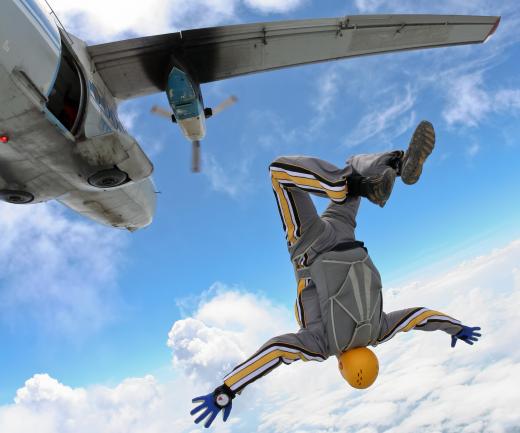At Sports&Hobbies, we're committed to delivering accurate, trustworthy information. Our expert-authored content is rigorously fact-checked and sourced from credible authorities. Discover how we uphold the highest standards in providing you with reliable knowledge.
Is Parachuting Safe?
Despite the seeming danger of jumping out of an airplane or glider, parachuting fatalities are rare. In the US and in most of the western world skydivers are required to carry a second, reserve parachute which has been inspected and packed by an FAA certified parachute rigger; many parachutists also use an altitude-sensitive automatic activation device (AAD) that activates the reserve parachute at a safe altitude if the skydiver somehow fails to activate the chute on their own. They also routinely carry both visual and audible altimeters to help maintain awareness of their altitude.
It should be emphasized that many of today's active parachutists have jumped for decades without significant injury. Injuries, when they do occur, are usually caused by inattention or improper action on the part of the parachutist. Some involve the parachute getting tangled up and thus not providing the full deceleration. These are very rare. Others arise from changes in wind forcing hard landings -- again, very rare. In recent years, one of the most common sources of injury is the inexperienced or overconfident (mis)use of perfectly good, high-performance parachutes to effect crowd-pleasing landings. High-speed maneuvers performed very close to the ground can be exhilarating to perform, and exciting to watch, but they usually increase the risk.

A parachute is carefully folded, or packed to assure that it will open reliably. In the U.S. and many developed countries, emergency parachutes are packed by "riggers" who must be trained and certified according to strict standards. Paratroopers and sport skydivers are always trained to pack their own primary parachutes.
When a parachute fails to open, it is usually a "streamer." In most streamers, the lines are twisted, and the canopy is prevented from opening enough to fill with air. Skydivers usually try to open a streamer by shaking the lines. If this fails, they cam rely on their emergency parachute also known as a "reserve chute".

About one in a hundred primary parachute openings is a streamer. Emergency parachutes have a better ratio, with between one in three hundred. Most skydivers believe that they can pack their primary parachutes as carefully as a professional rigger. Thus, a typical jumper can expect both parachutes to fail between once in 30,000 and once in 250,000 dives, depending on the care taken in packing the parachutes. Most lifelong skydivers retire before they reach 10,000 jumps.
Obviously skydivers should never pack their parachutes or jump when hurried, sleepy, drunk or on drugs. With proper care, the safety of skydiving can be increased drastically.

Some believe that the fundamental nature of skydiving indicates that it is inherently dangerous. On the other hand, statistics suggest that, with due care and attention (not to mention sound training and a good attitude) the more likely outcome is that hundreds of thousands of people make millions of jumps, and go back to do it again.
It is worth noting that what is depicted in commercial films -- notably Hollywood action movies -- usually exaggerates the dangerous-looking aspects of the sport. Often, the characters in such films are depicted performing feats that are physically impossible without special effects assistance. In other cases, their practices would cause them to be grounded or shunned at any safety-conscious drop zone or club.
In many countries, either the local regulations or the liability-conscious prudence of the dropzone owners require that parachutists must have attained the age of majority before engaging in the sport.
AS FEATURED ON:
AS FEATURED ON:













Discussion Comments
A few points, coming from someone who's very very current in skydiving: The failure rate of mains is much closer to 1 in 1,000 than in 300.
Double malfunction rates are not a simple matter of squaring this number, because many double mals (as rare as they are) have to do with interactions between the main and reserve, not at all with a reserve failing to open properly on its own.
Streamers aren't that common nowadays. As the main source of malfunction leading to a main cutaway, they've been largely replaced by high performance canopies fully opening but with twisted lines, thus failing to flatten out, engaging a simultaneous spin and dive which should be quickly acted upon.
To the article's point, when people ask me if skydiving is safe, I usually answer that it depends what you do, but that it's probably about as dangerous as driving a car on the freeway, and safer than driving a motorbike.
Just like driving, you can choose to do it more or less safely, or more or less dangerously as well. One difference is you have less of a tendency to be in danger because of others than you do on the road (though it remains possible, depending on the type of jump, and how many people are participating). A simple solo jump is extremely safe. A freefly zoo jump (people doing whatever they feel like in the sky around you), or a "big way" jump (hundreds of jumpers) is much more dangerous. So the answer really is "it depends".
Post your comments